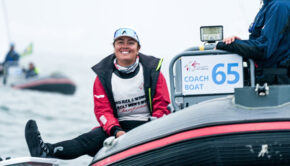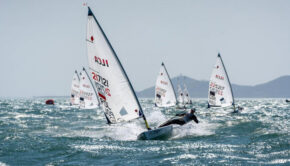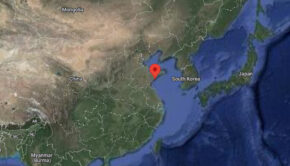What To Do When Anything Can Happen
Published on August 20th, 2018
If we had a favorite performance at the 2018 Sailing World Championship, which brought together all 10 Olympic events for a monstrous gathering of elite level competition, it quite likely would have been Canadian Sarah Douglass in the Laser Radial.
She’d been putting in the time, and her 6th place finish was her best ever at an international event. Getting to the Olympic podium is a process, and it is vital to be comfortable and confident to achieve that goal. There’s no magic potion for that… you have to get it to get it.
The Olympic event format might seem simple, with only the top ten advancing to the final race to determine the champion. But the procedure for the last race is unlike anything else in our sport and is fully disruptive to a person’s routine. Sarah shares the experience of doing her first medal race.
Lights, Camera, Action: 10 boats, double points and fully televised. This was a new experience for me and I learned about all the protocols required at the Hempel Sailing World Championships. All 10 boats were gathered in the medal race boat park and we had various steps to complete before heading out on the water such as trackers, equipment inspection, and cameras or dummy weights to be installed.
Anything can happen in a medal race and I had to prepare and know what were the potential outcomes, not only for myself but also for the other athletes. So that morning, my coach and I sat down and went over the numbers. Huge shout out to Head Coach Ken Dool for sending an excel spreadsheet with the points breakdown.
We had practiced medal race scenarios back at home in June, so I understood what could happen. Looking at the points, I was in a great position going into a double points medal race. I could not move down in the overall standings and I had a chance of a bronze medal.
Due to the points being so close from 3rd overall and where I was in 6th, there was a small chance of any athletes match racing as they risked moving down the leaderboard. My plan was to sail my own race, sail fast, and ask coach where I fell on the overall leaderboard once I crossed the finish line.
First when I showed up at the boat park, it was 35 knots on the course and I wasn’t sure if we were racing on time or even that day at all. But soon the wind dropped and we headed out for the medal race and the conditions were a shifty offshore from 10-20 knots. After a 3-minute start, we were off.
I started near the pin and it was a battle, each athlete was pushing hard. The shifty offshore breeze meant a lot of tacks and a constant switch up in the standings on the first upwind leg. I rounded the mark in 2nd place behind GBR heading downwind, but 3 of the top 5 got a rule 42 (propulsion) penalty, including myself.
After falling back to 4th place I fought hard on the next upwind. I rounded 3rd at the top mark as we headed to the finish on the final downwind. As I started to let my sail out, I had a massive mainsheet knot and couldn’t release my sail all the way. I spent almost half of the downwind trying to untie this knot and lost 4 boats because of it.
In the boat I sail, we have these long mainsheets and can sometimes tangle but I hadn’t had a knot to this magnitude in almost three years. Perhaps if I was more experienced I would have gybed as soon as I discovered the knot so that I would have the inside advantage for the bottom mark and correct side of the downwind. I finished 7th in the race and very frustrated with myself.
These kind of mistakes happen, but you can bet your bottom dollar that I will not have a mistake like that again. I was so close to a podium finish and moving up but I can’t play a game of what ifs. I have to face reality and will be using that frustration to fuel my training and future regattas.
Watch the medal race below:








 We’ll keep your information safe.
We’ll keep your information safe.